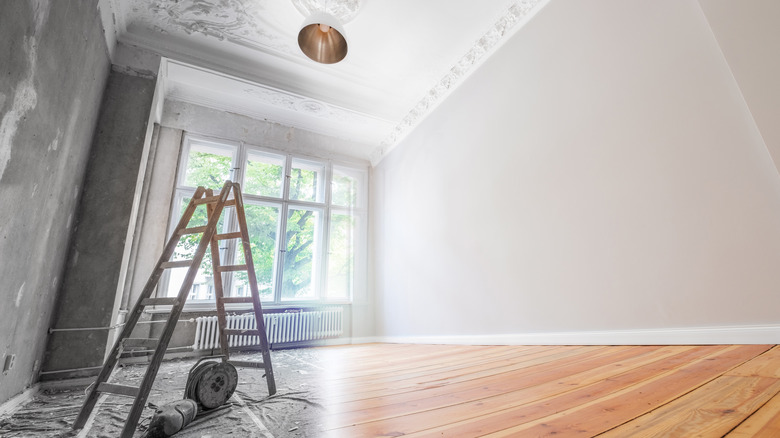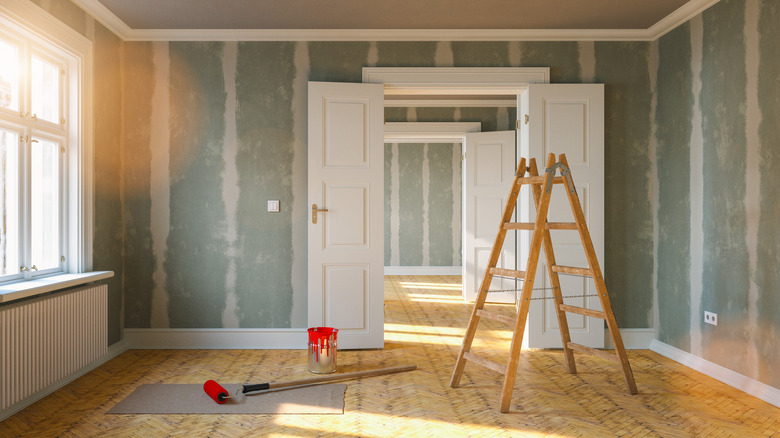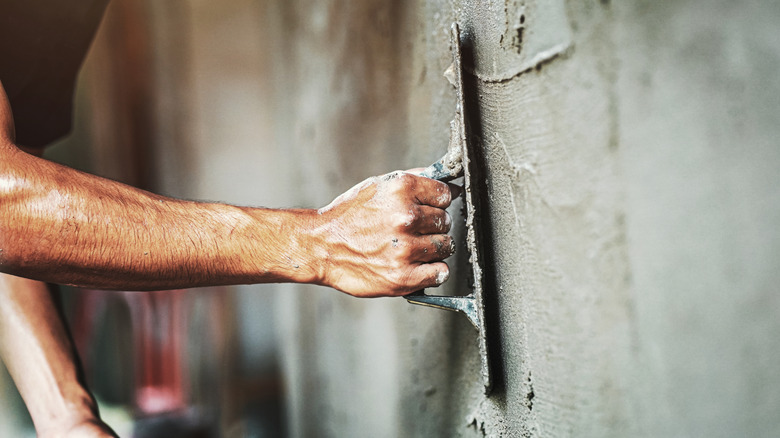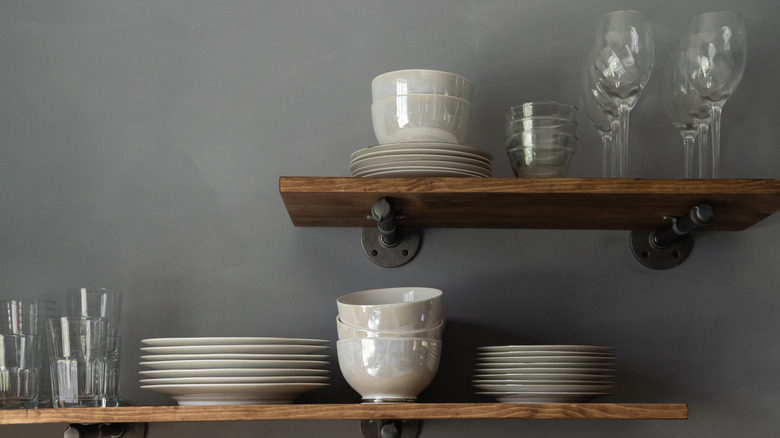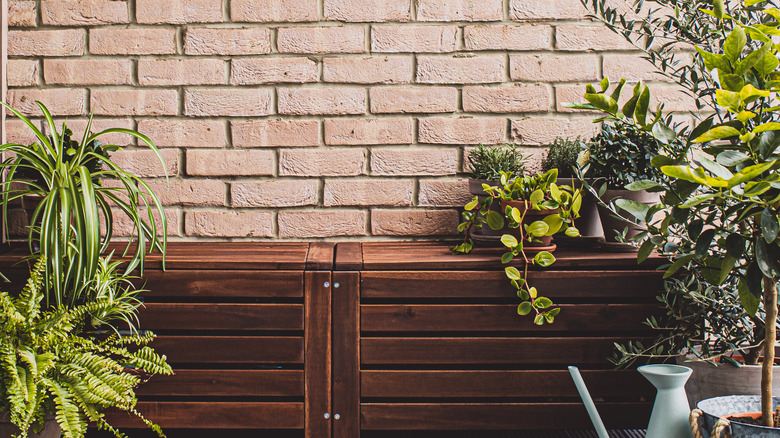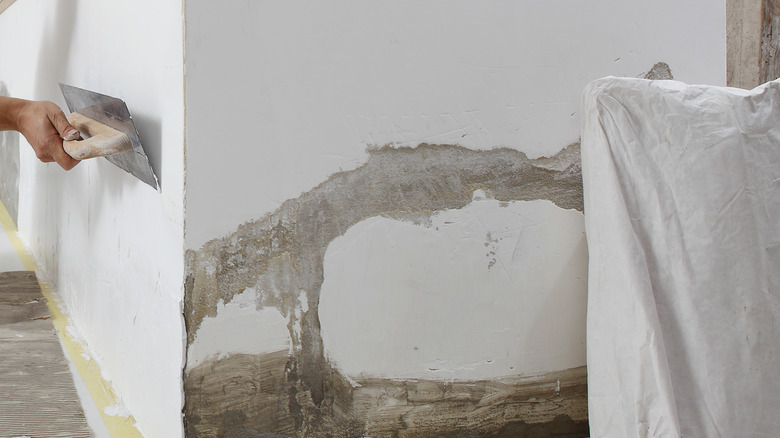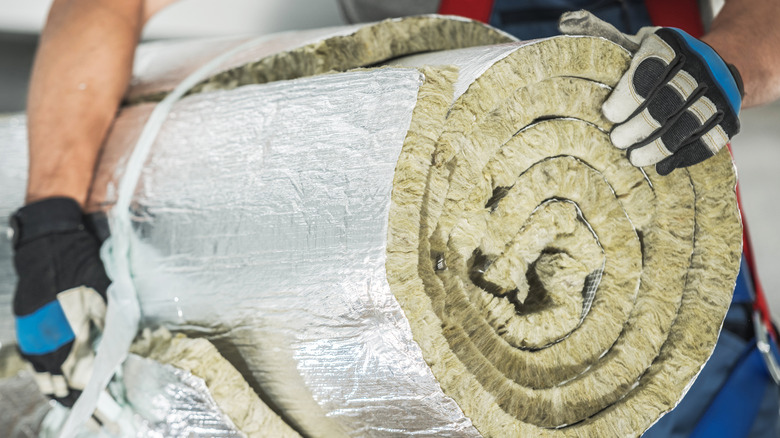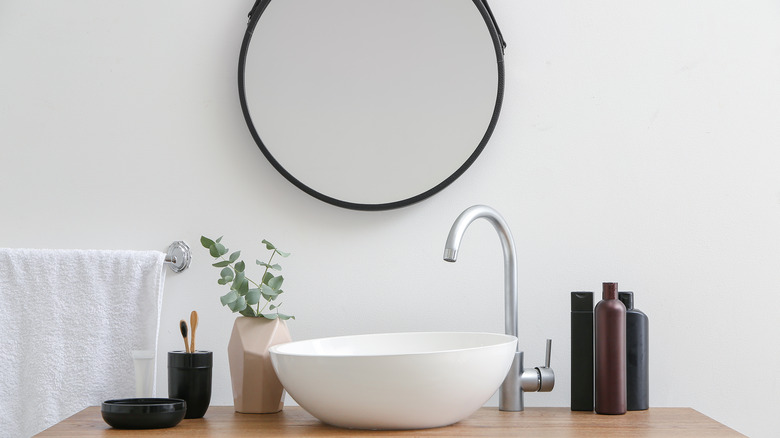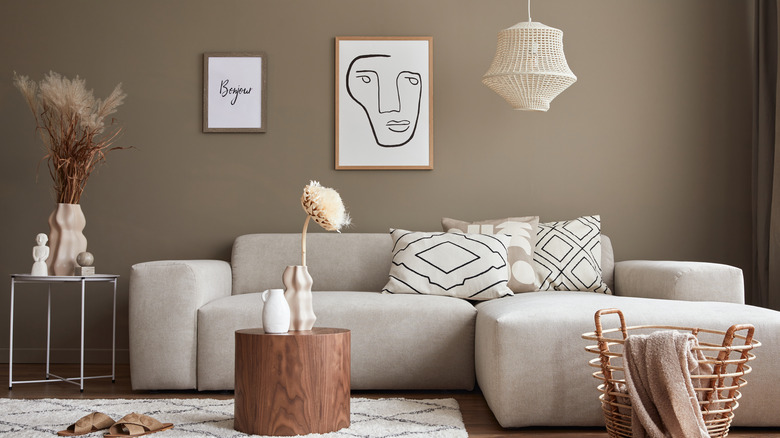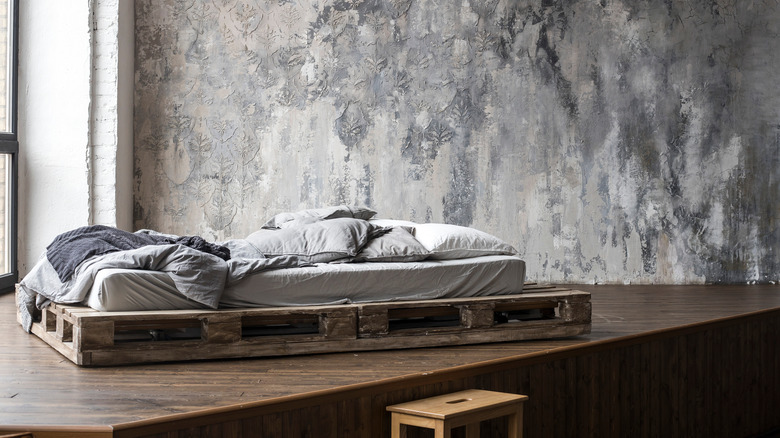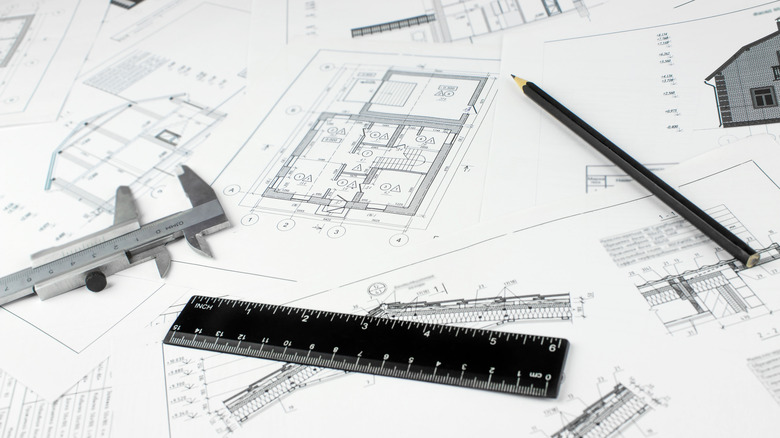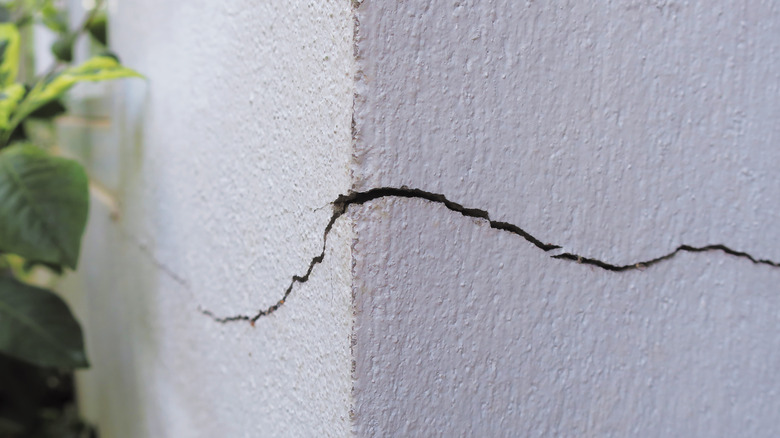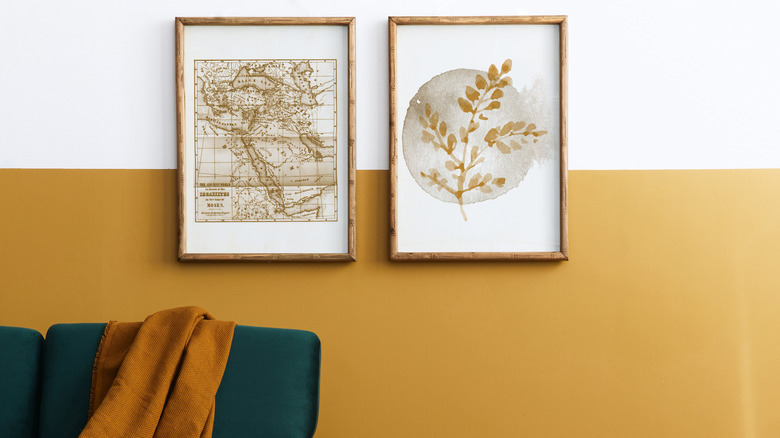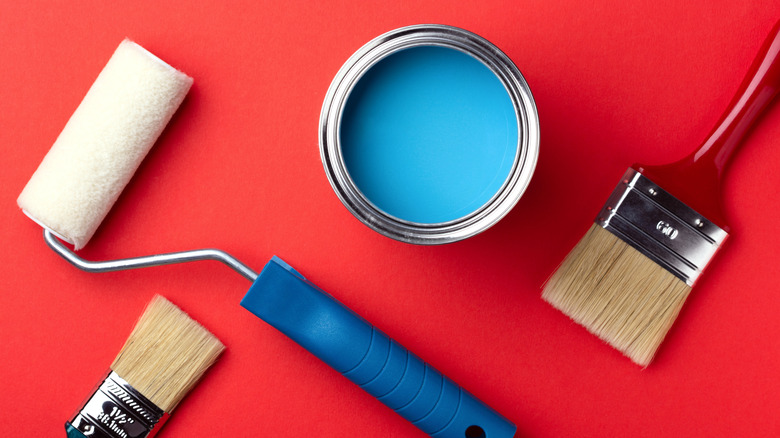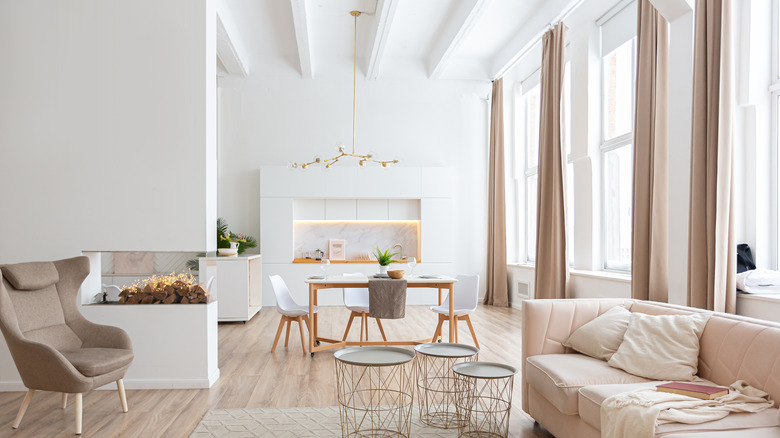Plaster Walls: What To Know Before You Buy
When you think of plaster walls, the first thing that comes to mind may be old houses built in the early 1930s or ancient ruins made of natural materials. While this architectural trend may seem outdated, it's making its way back into modern design and construction. According to Walls & Ceilings, the earliest use of plaster can be traced back to 7,500 B.C. During this time, a plaster-like substance coated mud-brick walls and floors. The best-preserved example of ancient plasterwork dates back to the 3rd millennium B.C. Egypt when gypsum and lime composite coated the inside of the pyramids.
Today the composition of plaster isn't too different from its ancient counterparts. Nowadays, it is composed of clay, lime, gypsum, sand, animal hair, cement, and mud (via PlasterMagic). However, most modern types do not need a fibrous binder because they use the crystalline structure in gypsum, allowing the material to lock together during the curing process. Keep reading for everything you need to know about plaster walls before you buy.
Plaster versus drywall
While many people mix up plaster and drywall, the two aren't interchangeable. According to Bob Vila, drywall became popular during WWII in construction due to the shortage of skilled installers. Today, this trend continues because drywall is less expensive and requires little specialized skill. The drywall installation process is straightforward, and homeowners with some DIY savvy can install it themselves. Additionally, because plaster requires skilled trades workers, it can cost up to three times the amount for drywall installation.
However, because drywall is only two sheets of heavy backing paper with a gypsum core, it is less durable than plaster which is a paste that may contain gypsum and clay (via The DIY Hammer). Plaster cures to an almost rock-like consistency, while drywall has a small cavity between the material and the wood base. While this makes drywall easier to cut, drill, and repair than plaster, it may not be the best option for homeowners that want walls without mold or moisture.
Common problems with plaster walls
Plaster is still a common material worldwide since it is mold and fire-resistant. However, because the material is a mixture of porous material, it has the same problem as granite and marble countertops — it can crack. According to Angi, plaster layers dry over a lath key during installation. As time goes on, the plaster layers can break at weak spots or exposed places on the wall. Additionally, in some climates, plaster walls will expand and contract as weather changes, which can cause cracking. Luckily, for most houses with plaster walls, the cracks are usually only cosmetic and can get easily repaired by a specialist. However, most cosmetic cracking of plaster happens in the first few years of a home. If a house is older than a decade and starts to crack, it may signal an issue with the foundation.
Another common issue with plaster is that it will discolor as an early sign of water damage. While it is possible to prevent stains with a stain-blocking primer, consult a professional when you start seeing brown discoloration showing up on your plaster walls (via European Plastering). Additionally, if the problem does not get addressed, the plaster will bubble and bulge out at the place of the leak. If you do not remove the bubble or treat the leak, you may see mold buildup in the area, which will damage the wall further.
How to plaster walls without plastering your walls
While many people use plaster in their homes for a stylish look, not everyone can afford to install it on their walls. A great way to get the look and feel that plaster brings to an interior is by using a lime or plaster wash on your walls. Limewash originated in ancient Rome, where it would be crushed and mixed with water to create a putty. According to Remodelista, water and pigment thinned the putty to create a mottled matte finish for painting walls. Traditionally, limewash applies to plaster, stone, cement, and stucco walls, but with a few additives, you can add it to drywall to help create the texture of a Venetian plaster finish on your wall.
Limewash is commonly done in cool grays, tans, browns, whites, and ivories (via Harper's Bazaar). Since the lime in the paint mixture is white, light shades dry with a dreamy look, while mid-tone and deep colors showcase more texture.
Alternatives to plastering a wall
Plaster and drywall aren't the only options for finishing a wall. There can be many reasons homeowners and builders might want to move away from using gypsum-based materials in their construction projects. According to Eco Home, synthetic gypsum board, commonly called synthetic drywall, can be used when gypsum isn't in a construction project. Synthetic drywall contains up to 96 percent of recycled content from the waste of industrial chimneys.
However, there are still options beyond drywall that homeowners and builders can use in their projects. For example, tongue and groove interior wood walls give a cabin-like feeling to their spaces and can be oiled or stained to bring out the pine wood color. Another option is using bricks and masonry, which can help balance the temperature in the home. Some builders may also choose to use plywood wall coverings instead of drywall, which add a modern finish to a space while being eco-friendly. Additionally, hemp is becoming a common material in the construction space due to its ability to provide soundproofing and insulation.
Why use plaster walls
Choosing between wall finishes is an essential step dependent on cost and benefits that match your lifestyle, budget, and needs. The original plaster in many houses before the 1940s is still standing with minor damage. On the other hand, drywall can get damaged with exposure to water or accidental force due to its paper composition. According to Master Plastering & Services, plaster resists fire and is not as vulnerable to water damage as drywall.
While plaster can develop small stress cracks, many are cosmetic and easily fixed. Plaster also can be molded and shaped to add texture or artistic finishes to a wall, while drywall is flat. Additionally, plaster is more soundproof than drywall and preferred by musicians because of the richer sound it produces. Plaster is also more energy-efficient than drywall because it's nearly twice as thick as traditional drywall installation (via The Craftsman Blog).
Adding insulation to plaster walls
According to Angi, older homes are prone to drafts because air flows through cracks, allowing homes to keep cool in the warmer months. Nowadays, with the advancements in air conditioning and centralized heating, it's essential to keep our air inside. It's a top priority to insulate plaster walls and old houses to avoid moisture problems and wood rot (via Professional Remodeler).
If a home's attic or roof is fully insulated, adding insulated walls will help bring lower energy costs (via This Old House). If you plan on adding insulation to your walls, there are plenty of options from fiberglass plastic, shredded paper, wool, and denim scraps. A typical insulation material homeowners gravitate towards is expanding foam. This material is a polyurethane or cement that goes on as a soft liquid and stiffens when dry. Only professionals apply this material, which is a good option for those who can afford to invest because it's a long-term solution that requires little maintenance. The cost is around $1.50 per square foot, including labor. Batts, another option, are easily installed by homeowners and cost about $0.40 per square foot of material. Batts are a thick fabric composite, usually made of fiberglass, cotton, or wool, that comes in large rolls. While this option is easier to install and requires no professionals, it can be harder to source and install organic material.
When to waterproof plaster walls
According to Waterproof Tips, plaster has a high degree of water resistance because of the lime or gypsum content in the mixture. However, there is no regulated plaster that every contractor has to use. For this reason, every job could have a different degree of water resistance. While some interior walls may not need waterproofing, bathroom or exterior walls commonly do. Exterior plaster does not need to be waterproof because it has cement to help it withstand extreme weather conditions (via Everything What). However, if you choose to add additional waterproofing to your exterior plaster walls, it can prevent seepage and dampness. You can spray a plaster topcoat known as mist coating, which gets sucked up by the plaster and hardens in the pores, making the material more resistant to moisture.
To waterproof interior plaster walls, it's essential to apply a waterproofing membrane to the mixture (via Stucco Italiano). This step is common when having plaster installed in a bathroom or shower. The membrane creates a rubbery, flexible finish and must be installed by a professional. Since standard waterproofing methods will crack and not hold onto plaster, professionals should install a coat of fiber-reinforced plaster. They can apply a polyester or fiberglass mesh over it and finish with a stucco finish for the walls.
Know which plaster options are available for you
When installing plaster, it's important to note that there are different types, and all have specific installation processes, costs, and looks. According to Homebuilding & Renovating, the most common types of plaster are lime and gypsum. Lime plaster is composed of lime, sand, water, and fibers that help it bind to the wall. This plaster is breathable and can prevent dampness and condensation. It's also flexible and has a stone finish, making it a favorite for structures that experience movement or harsh weather conditions.
Gypsum plaster is a mix of dehydrated gypsum and hardening compounds. It's less flexible and not as water-resistant as lime plaster, but it's cheaper and has a smoother finish. You can also use cement plaster in your home, which features a mixture of cement, sand, and water. This material is a low-cost option, but it's not as breathable or flexible as lime. It's commonly used with gypsum plaster to achieve a smooth finish.
Types of plaster finishes
Plaster comes in many different textures. According to The Constructor, it can be smooth cast, roughcast, sand faced, pebble dash, scrapped, depeter, or textured. You can alter the plaster to match the aesthetic of your home. For example, you can add stenciling to hide cracks and bumps in the wall and add texture (via Hunker). This tip is typical for faux brick or paneling found in homes from the 1970s. Additionally, plaster with cement can have a stucco finish applied to it.
When renovating your home, you may want to use a Venetian finish on your plaster. Venetian plaster involves adding a marble dust pigment to lime plaster (via Remodelista). You can apply a Venetian plaster finish to your existing drywall or plaster (via The Spruce). Since it's difficult to install, it's best to practice on drywall sheets and test the colors you're planning to use. To add Venetian plaster to existing walls, sand down the surface and follow the specific instructions closely. After painting the walls with the putty mixture, burnish the surface with fine sandpaper and clean the wall.
Hire a professional contractor or plaster expert
While you can apply plaster to your existing walls or make minor repairs, it's best to have it installed and maintained by a licensed trade professional. Plaster differs from drywall and is a lot more skill-based. While you might not want to spend the money for professional installation, it will be more efficient in the long run. Even small mistakes can damage the integrity and cause long-term water damage or structural cracking.
According to Master Plastering & Services, improperly installed plaster can hinder a home's value. Properly installed plaster can raise value because it's more durable than drywall and looks luxurious. Avoid making the mistakes everyone makes when hiring contractors. Look for the most experienced contractor in your area for plastering since it's a specialized trade (via Sheldon & Sons, Inc). To find the best one in your area, you can contact local paint companies and builders to see who they recommend. Additionally, your local home improvement store should have a list of contractors that have been proxied.
How to repair small cracks in plaster
There will occasionally be times when plaster cracks or needs repair. Although the material is hard as stone, sometimes stress lines form or crack at impact. The damage is usually cosmetic, but it is essential to watch the problem if it comes from the foundation. According to HomeAdvisor, you can hire a professional to fix plaster walls. Depending on the damage, the cost is around $10 to $100 per square foot. However, some professionals may charge per crack instead of per square foot.
If the damage is cosmetic and you feel comfortable tackling it yourself, it's easy to repair minor cracks in a plaster wall. You simply need to clean the crack and make sure all the compound, paint flakes, and other debris is scraped out (via This Old House). Next, apply a thin layer of joint compound and pull off any excess. Use a mesh material to bind the compound, and place a second layer on top. Finally, sand the area and apply a third coat of compound.
How to hang items on plaster walls without damaging them
It can be challenging to hang pictures, wall art, or decorations on your plaster walls. According to The Craftsman Blog, plaster is a hard material with a lath behind for support. On the other hand, drywall is thinner and doesn't have one, making it easier to puncture. There are also drywall anchors available for hanging art. Some older homes have a picture rail installed into their plaster, which protects the wall while giving you a place to hang items.
If you do not have a picture rail in your plaster, instead of using nails, screw a masonry anchor into the wall, preferably into the lath. If you do not want to screw anything into the wall, you can also use command hooks and strips on plaster (via Pepper's Home & Garden). To make sure your command strip adheres to the plaster wall, clean the surface with rubbing alcohol first.
Plaster is potentially an allergen
Plaster is rarely an allergen, but the composition can become a problem for many people. According to AZCentral, you can do a patch test to see if you're allergic to the specific blend before installing plaster. It is possible to be allergic to one type, like lime plaster, and not others. A contractor should be able to test if you're allergic before starting a construction job. Symptoms of plaster allergies are a runny nose, congestion, or contact dermatitis. However, some people do get red eyes or a loss of breath. People with asthma are more likely to be allergic or reactive to the elements in plaster. Additionally, people sensitive or reactive to drywall will likely have allergy flare-ups to the gypsum in some plasters.
Some individuals are also allergic to small traces of hexavalent chromium, an element found in cement (via Neutralite Safety Solution). By nature, cement is also corrosive and can penetrate layers of skin. While this isn't a problem for most people, it's essential to pay attention during your renovation projects to see if you have any allergy-like symptoms. You can prevent flare-ups or skin damage by wearing a mask and gloves when handling plaster.
How to paint plaster walls
At some point, you will probably want to paint your plaster walls. Painting plaster requires a little bit of extra prep work. According to J Canabe's Painting Company, before you paint or prep your plaster walls, you should fix any damage using a high-quality patching compound. Painting over plaster without fixing it can lead to more damage that will go unseen until a problem arises (via Angi).
Plaster walls also require an oil-based primer, which is not typical for painting drywall. To prep plaster walls, make sure they are dry. This process typically takes a week for newly installed plaster and older walls with patching compound. Next, spray your walls with an emulsion paint mixture to provide your latex paint with a sticky surface. After the emulsion mixture has dried, typically 24 hours, apply a topcoat in a v motion. Once it has cured, you should be able to paint your walls like normal.
Using plaster in your design for a modern look
According to Architectural Digest, plaster walls are all the rage right now. While once seen only in older homes, plaster is no longer a thing of the past. They've been making a steady comeback since the 2010s. Professional designers say plaster walls bring realness and warmth to their designs, and clients have been requesting this material since COVID lockdowns. Technological advances in design and construction have allowed for more customization of plaster (via Curbed).
Many homeowners ask for plaster finishes for their interior and exterior, which allows the home decor to interact with the environment. Unlike paint, plaster does not emit volatile organic compounds (VOCs), making it a favorite for individuals with allergies and pre-existing conditions. It can also help a home look less sterile by bringing texture into the space. In particular, light-colored plaster features a unique and dreamy appearance.
